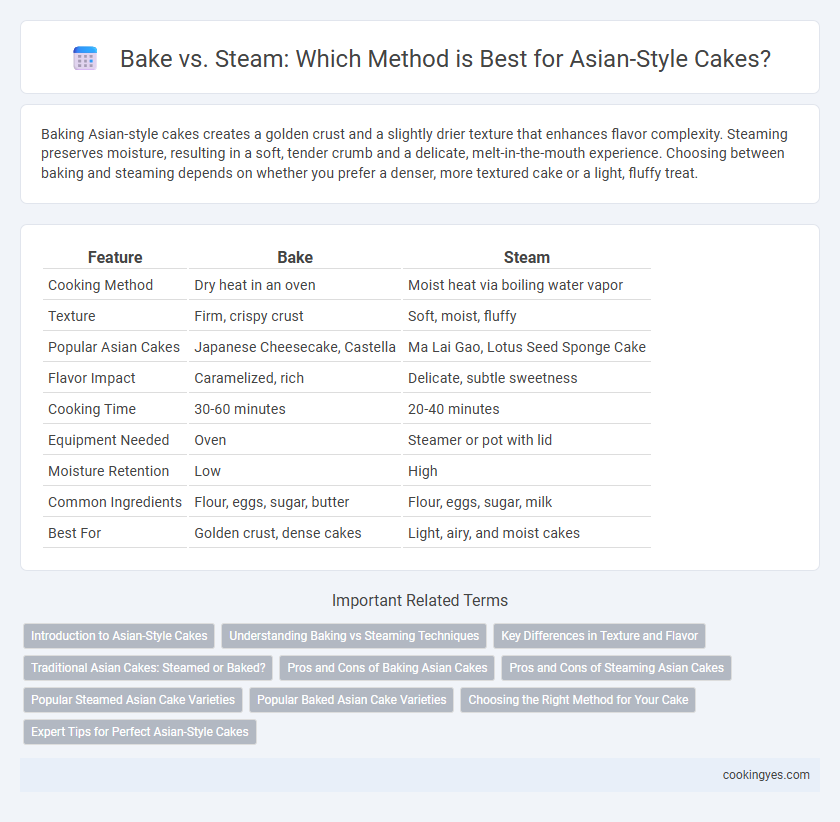Baking Asian-style cakes creates a golden crust and a slightly drier texture that enhances flavor complexity. Steaming preserves moisture, resulting in a soft, tender crumb and a delicate, melt-in-the-mouth experience. Choosing between baking and steaming depends on whether you prefer a denser, more textured cake or a light, fluffy treat.
Table of Comparison
| Feature | Bake | Steam |
|---|---|---|
| Cooking Method | Dry heat in an oven | Moist heat via boiling water vapor |
| Texture | Firm, crispy crust | Soft, moist, fluffy |
| Popular Asian Cakes | Japanese Cheesecake, Castella | Ma Lai Gao, Lotus Seed Sponge Cake |
| Flavor Impact | Caramelized, rich | Delicate, subtle sweetness |
| Cooking Time | 30-60 minutes | 20-40 minutes |
| Equipment Needed | Oven | Steamer or pot with lid |
| Moisture Retention | Low | High |
| Common Ingredients | Flour, eggs, sugar, butter | Flour, eggs, sugar, milk |
| Best For | Golden crust, dense cakes | Light, airy, and moist cakes |
Introduction to Asian-Style Cakes
Asian-style cakes often emphasize light, airy textures achieved through steaming, which preserves moisture and enhances natural flavors without browning. Baking creates a drier, firmer crust and introduces caramelized notes that contrast with the soft interior typical of steamed cakes. Understanding the distinct methods helps highlight the cultural preferences and culinary techniques central to Asian dessert traditions.
Understanding Baking vs Steaming Techniques
Baking Asian-style cakes creates a firm, golden crust with a drier texture, intensifying flavors through Maillard reaction, while steaming yields a moist, tender crumb with a delicate, soft surface. Steaming preserves moisture and keeps ingredients like rice flour or mung beans from drying out, ideal for traditional recipes such as Chinese sponge cake or Malaysian kuih. Understanding heat transfer differences--dry heat in baking versus moist heat in steaming--allows precise control over texture and taste in Asian cake preparation.
Key Differences in Texture and Flavor
Baking Asian-style cakes produces a firm, golden-brown crust with a slightly drier texture, enhancing caramelized flavors and a crisp outer layer. Steaming results in a moist, soft, and tender crumb with a pale appearance, preserving the delicate sweetness and natural aromas of ingredients like matcha or pandan. The choice between baking and steaming significantly influences the cake's mouthfeel and flavor intensity, making steaming ideal for lighter desserts and baking better for rich, dense cakes.
Traditional Asian Cakes: Steamed or Baked?
Traditional Asian cakes often rely on steaming to achieve their distinct soft and moist texture, as seen in delicacies like Chinese sponge cakes (ma lai gao) and Philippine puto. Steaming preserves the cake's delicate crumb and enhances subtle flavors without browning, unlike baking which creates a firmer crust and drier texture typical in Western-style cakes. The choice between steaming and baking significantly influences the cake's moisture level, tenderness, and authenticity in Asian culinary traditions.
Pros and Cons of Baking Asian Cakes
Baking Asian cakes creates a golden, slightly crisp exterior and enhances flavors through Maillard reactions, offering a rich texture unmatched by steaming. However, baking can dry out the fluffy, delicate crumb typical of traditional Asian cakes, requiring precise temperature control to maintain moisture. While steam preserves softness and moisture, it lacks the depth of flavor and browned crust that baking delivers, making baking ideal for denser cakes like chiffon or sponge varieties.
Pros and Cons of Steaming Asian Cakes
Steaming Asian cakes preserves moisture and creates a soft, tender texture, making them ideal for delicate rice flour or glutinous rice-based recipes. This method avoids browning and crust formation, maintaining a smooth surface, but it can result in a slightly denser cake compared to baking. Steamed cakes also require careful temperature control to prevent sogginess and ensure even cooking throughout.
Popular Steamed Asian Cake Varieties
Steamed Asian cakes like Chinese Ma Lai Gao, Vietnamese Banh Bo, and Filipino Puto offer a moist, fluffy texture that distinguishes them from baked counterparts. The steaming method preserves delicate flavors and enhances the soft, spongy consistency unique to these traditional desserts. Popular steamed varieties emphasize natural sweetness and subtle aromas, reflecting regional preferences and ingredients.
Popular Baked Asian Cake Varieties
Popular baked Asian cake varieties include classic Castella from Japan, characterized by its light, fluffy texture and honey-infused sweetness, and Taiwanese pineapple cake, known for its crumbly pastry and rich pineapple filling. Malaysian sponge cake, often baked with pandan leaves, offers a fragrant, moist taste, while Chinese mooncakes are baked pastries with dense, sweet fillings such as lotus seed paste or red bean. These baked cakes differ from steamed counterparts by having a firmer, drier texture and a golden-brown crust, providing a distinct contrast to the soft, moist consistency of steamed Asian cakes.
Choosing the Right Method for Your Cake
Choosing the right method for Asian-style cakes depends on texture and flavor preferences. Baking produces a golden crust with a denser crumb, ideal for chiffon or sponge cakes, while steaming results in a moist, soft texture commonly found in traditional rice cakes and steamed sponge cakes. Understanding the ingredients and desired cake characteristics helps determine whether baking or steaming best enhances the authentic taste and appearance.
Expert Tips for Perfect Asian-Style Cakes
Steaming Asian-style cakes preserves moisture and creates a soft, fluffy texture ideal for traditional recipes like sponge cakes and chiffon cakes. Baking produces a slightly firmer crust and richer flavor, suitable for denser cakes like mooncakes or butter cakes. Experts recommend using steaming for delicate rice flour or taro cakes, while baking works better for cakes with butter or cream-based batters.
Bake vs Steam for Asian-style cakes Infographic

 cookingyes.com
cookingyes.com